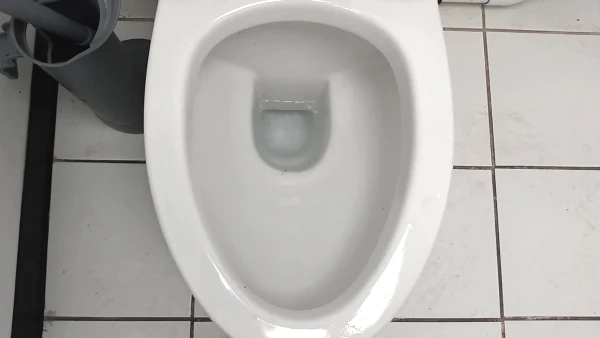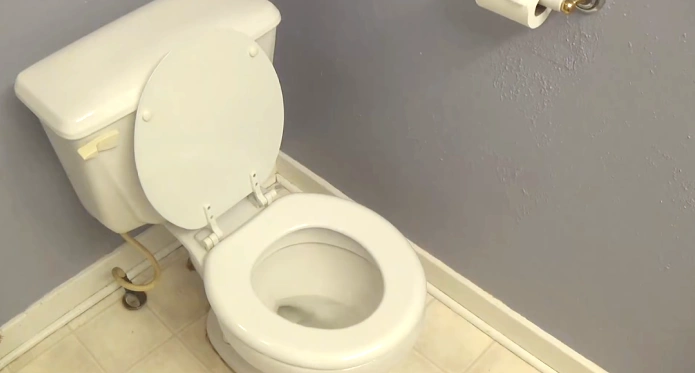Last Updated on October 18, 2023
You may have noticed your toilet bowl water moving mysteriously when it is windy outside. This seemingly peculiar condition is caused by a combination of factors related to your plumbing system, atmospheric conditions, and even the design of your toilet.
One factor is Bernoulli’s Principle, which states that as the wind blows over the roof of your house, it creates a low-pressure area. This low pressure causes air to rush down through the plumbing system, displacing water. Also, temperature variations can contribute to these movements.
We’ll explore whether it indicates a plumbing problem or if there are any long-term consequences. So keep reading for a whirlwind of knowledge.
What Causes Water in the Toilet Bowl to Move When It’s Windy Outside?

When it’s windy outside, you may notice that the water in your toilet bowl starts to move. Several factors can explain this phenomenon, such as:
- Bernoulli’s principle
- Vent stack effect
- Temperature variations
- Plumbing system design
- Ventilation and obstructions
- Wind intensity
Bernoulli’s Principle
As the wind blows over your home’s roof, it causes a decrease in pressure inside the plumbing system due to Bernoulli’s Principle. According to this principle, an increase in fluid flow corresponds to a simultaneous decrease in pressure.
The wind passing over the plumbing vent stack, a pipe extending upwards and venting sewage gasses, increases speed. This increased wind speed lowers the air pressure inside the plumbing system. Consequently, a suction effect is created within the pipes, directly impacting your toilet’s water level.
When the intensity of the wind fluctuates, so does the movement of water in the bowl. Therefore, understanding Bernoulli’s Principle provides insight into why water moves in your toilet when it’s windy outside.
Wind Intensity
Wind plays a significant role in creating suction within the plumbing system, which affects water movement. When strong gusts of wind blow, they generate a more substantial suction effect, leading to more pronounced water movement in the toilet bowl.
This occurs because the force exerted by the wind enhances the pressure difference between the inside and outside of the plumbing system. However, when the wind subsides or weakens, so does this suction effect, resulting in less noticeable water movement in the toilet bowl.
Vent Stack Effect
The vent stack effect, influenced by strong winds or storms, can result in fluctuations in air pressure within the plumbing system.
When there are high winds or a storm outside, the wind blows over the vent stack, maintaining proper air pressure in the pipes. This external air pressure can cause changes in your plumbing system’s air pressure.
As a result, you may notice fluctuations in the water levels in your toilet bowl. The movement of water occurs because of this change in air pressure. These temporary fluctuations will return to normal once the external wind or storm subsides.
Temperature Variations
Temperature changes affect the air pressure in the plumbing system, leading to fluctuations in the water levels of your toilet. When extreme temperature shifts, like during storms, the air inside the pipes can either expand or contract.
This volume change alters the pressure within the system and causes water movement in your toilet bowl. For example, if the surrounding temperature increases rapidly, the air inside the pipes expands and pushes on the water, resulting in a rise in water level.
Conversely, when temperatures drop suddenly, causing contraction of air inside the pipes, it creates a vacuum effect that pulls water from your toilet bowl. These temperature variations determine whether your toilet’s water level rises or falls.
Plumbing System Design
Homes with longer or more complex plumbing systems may experience noticeable fluctuations due to the potential for greater changes in air pressure within the pipes.
The design and layout of your plumbing system play a crucial role in how water moves in the toilet bowl. A complicated plumbing system with numerous twists, turns, and joints can create more opportunities for air pressure changes, resulting in erratic water movement.
Also, if your home has an extensive network of pipes far apart, you may experience more significant fluctuations due to longer distances for air pressure to equalize.
Ventilation and Obstructions
In the plumbing system, vent stacks allow air to enter and exit the pipes, ensuring smooth drainage and preventing pressure changes.
However, obstructions such as debris or animal nests can impede the proper ventilation of the plumbing system. This can lead to negative pressure inside the pipes, affecting the water level in the toilet bowl.
Is water movement in the toilet bowl a sign of a plumbing problem?

Minor water movement caused by wind is typically normal and not a cause for concern. However, persistent or extreme water level fluctuations in the toilet bowl may indicate an underlying plumbing issue that a professional plumber should inspect.
Can I prevent water movement in the toilet bowl on windy days?
On windy days, you can minimize water movement in the toilet by ensuring your plumbing vent stack is clear and your system is well-maintained.
The plumbing vent stack is crucial in maintaining proper air pressure within your plumbing system. It allows air to enter and exit, preventing any negative pressure that could cause water to move in the toilet bowl.
Keeping the vent stack clear of obstructions such as debris or bird nests ensures that air can flow freely, reducing the chances of water movement.
Does the direction of the wind affect water movement in the toilet bowl?
The direction of the wind can have an impact on how the water in the toilet bowl behaves. When wind blows directly over the vent stack, it creates stronger pressure changes that affect water movement in the bowl.
These pressure changes can result in noticeable water activity in the toilet bowl, such as swirling or splashing.
Are there any long-term consequences of water movement in the toilet bowl?
If you ignore the occasional movement of water in your toilet bowl, it could lead to more serious plumbing issues down the line.
While wind-induced movement in the toilet bowl may not cause immediate damage, address any additional plumbing issues that may be present. Leaks or blockages can exacerbate the problem and result in long-term consequences.
For instance, a leaking pipe can lead to water damage and mold growth, which poses health risks and requires costly repairs. Also, persistent blockages can cause sewage backups and overflowing toilets, causing significant damage to your home and requiring extensive repairs.
Can weatherproofing my plumbing system help reduce water movement on windy days?
You can minimize the impact of windy days by weatherproofing your plumbing system. This is because strong winds change air pressure, affecting water movement in your toilet bowl.
Without proper insulation in exposed pipes and a clear vent stack, these pressure changes can cause the toilet water to move or even splash out.
Understanding and Preventing Water Movement in Your Toilet Bowl
When the wind is blowing outside, it can cause water movement in the toilet bowl. This situation does not necessarily indicate a plumbing problem and can be prevented by adjusting the ventilation system or installing a pressure relief valve.
The wind’s direction affects water movement, with stronger winds causing more noticeable effects. While this issue has no long-term consequences, weatherproofing your plumbing system may help reduce moving water on windy days.
Understanding the reasons behind this peculiar occurrence can help demystify the phenomenon and put your mind at ease the next time the wind picks up.

